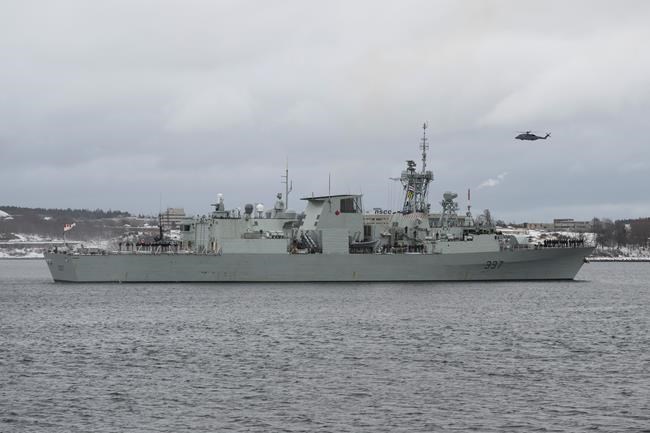
A Cyclone helicopter flies over HMCS Fredericton as its crew leaves the Halifax Harbour for a six-month deployment to the Mediterranean Sea as part of NATO's Operation Reassurance in Halifax on January 20, 2020. An internal Defence Department study has found that the Royal Canadian Navy's maintenance facilities are having a harder time fixing Canada's warships because of staff shortages, lack of spare parts and the overall age of the fleet. THE CANADIAN PRESS/Darren Calabrese
Republished March 06, 2020 - 1:45 PM
Original Publication Date March 06, 2020 - 12:11 PM
OTTAWA - The Royal Canadian Navy's maintenance facilities are having an increasingly tougher time fixing Canada's warships because of staff shortages, lack of spare parts and the age of the fleet, according to an internal Defence Department study.
The navy was also found to be critically short of sonar and sensor operators for its frigates while ongoing challenges in getting Canada's submarines into the water are hurting the navy's ability to train new submariners to crew them.
The study's findings were written last year but only published by the Defence Department this week. The Canadian Press recently reported on navy and Canadian Coast Guard needing hundreds more sailors between them to get up to strength.
The study found the navy was able to conduct nearly all of its overseas missions despite the challenges, in part by moving people and equipment around to where they were needed most. The exception was Canada's trouble-plagued submarines.
Navy officials also told those conducting the study that they were working on plans to address the underlying problems, including putting more money and staff into the fleet maintenance facilities in Victoria and Halifax.
The findings nonetheless reiterate the importance of addressing those personnel shortfalls both in terms of sailors and maintenance staff while underscoring the importance of preventing any further delays in the long-running effort to replace Canada's warship fleets.
The difficulties facing the maintenance facilities figured prominently in the study findings, which said the facilities "have been increasingly challenged to sustain the aging platforms and increasingly obsolete systems of the Halifax-class frigates and Victoria-class submarines."
The challenges were even found to extend to some systems only recently installed aboard the 1980s-era frigates as part of a major upgrade that is intended to keep them operating until new warships arrive, which is currently expected to happen in the late 2020s and early in the next decade.
In the meantime, "the obsolescence of certain parts and systems, including some recently installed (Halifax-class modernization) systems, and the growing age of the platforms themselves, remain significant issues," the study found.
The maintenance facilities were also found to have lost about 10 per cent of their staff over the past few years even as the demand for repairs steadily increased. The study did not say why staff were leaving.
Complicating matters was availability of spare parts, again part due to the age of the ships. In some cases, parts had to be taken from one ship or submarine that was docked in extended maintenance periods and put in another needing less work to get it out the door faster.
Despite the challenges, the navy was found to have been able to largely meet its requirements in terms of conducting overseas missions and having enough vessels ready to respond to emergencies.
However, the study was particularly hard on Canada's submarines, which were found to have not been able to operate as often as the government expected, in part due to problems with hull welds and the vessels' batteries and diesel generators.
None of the four vessels have operated since 2018, though the navy has said it expects some of the boats back in the water this year.
The government has said it plans to extend the lives of the four submarines, which Canada bought second-hand from Britain in 1998, at an estimated cost of more than $2 billion. But some have questioned whether Canada should just buy new submarines instead.
As for the shortage of sonar and sensor operators for Canada's frigates, the study attributed the issue to challenges in recruiting — a problem that was highlighted by Navy commander Vice-Admiral Art McDonald in an interview with The Canadian Press last month.
McDonald said at the time one of his priorities since taking over command of the navy last year has been getting more young men and women to sign up to sail with the navy, which is short roughly 850 members.
While McDonald said the shortfall is manageable now, the concern is what would happen should the navy find itself needing to dramatically ramp up its operations — something that can't be ruled out given the current state of the world.
This report by The Canadian Press was first published March 6, 2020.
News from © The Canadian Press, 2020